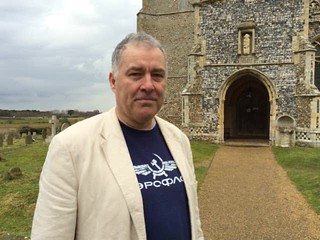| |
|
Holy
Trinity, Blythburgh
 |
|
Perhaps some counties have
a church which sums them up. If there has to be
one for Suffolk, it must be the church of the
Most Holy Trinity, Blythburgh. Here is the late
medieval Suffolk imagination writ large, as large
as it gets, and not overwritten by the Anglican
triumphalism of the 19th century. Blythburgh
church is often compared with its near neighbour,
St Edmund at Southwold, but this isn't a fair
comparison - Southwold church is much grander,
and full of urban confidence. Probably a better
comparison is with St Margaret, Lowestoft, for
there, too, the Reformation intervened before the
tower could be rebuilt. The two churches have a
lot in common, but Blythburgh has the saving
grace. It is so fascinating, so stunningly
beautiful, by virtue of a factor that is rare in
Anglican parish churches: sheer neglect.
Holy Trinity, Blythburgh, is the church that
Suffolk people know and love best, and because of
this it has generated some extraordinary legends.
The first is that Blythburgh, now a tiny village
bisected by the fearsome A12 between London and
the east coast ports, was once a thriving
medieval town. This idea is used to explain the
size of the church; in reality, it is almost
certainly not the case. Blythburgh has always
been small. But it did have an important medieval
priory, and thus its church attracted enough
wealthy piety on the eve of the Reformation to
bankroll a spectacular rebuilding. |
It is to Lavenham, Long Melford, Mildenhall, Southwold
and here that we come to see the late 15th century
Suffolk aesthetic in perfection. But for my money, Holy
Trinity, Blythburgh, is the most significant medieval art
object in the county, ranking alongside Salle in Norfolk.
Look up at the clerestory; it seems impossible, there is
so much glass, so little stone; and yet it rides the
building with an air of permanence. Beneath, there is a
coyness about the aisles that I prefer to the mathematics
of Lavenham. Here, it could not have been done otherwise;
it distils human architectural experience. If St Peter
and St Paul at Lavenham is man talking to God, Holy
Trinity at Blythburgh is God talking to man.
At the east end, a curious series of initials in
Lombardic script stretch across the outer chancel wall.
You can see an image of this at the top. It reads
A-N-JS-B-S-T-M-S-A-H-K-R. This probably stands for Ad
Nomina JesuS, Beati Sanctae Trinitas, Maria Sanctorem
Anne Honorem Katherine Reconstructus ('In the name of the
blessed Jesus, the Holy Trinity, and in honour of Holy
Mary, Anne and Katherine, this was rebuilt'). A fanciful
theory is that they are the initials of the wives of the
donors. However, note the symbol of the Trinity in the T
stone, and I think this is a clue to the whole piece.
Figures stand on pedestals atop the south side and east
end. The most easterly is unusual, a crowned old man
sitting on a throne directly on the gable end. This is a
medieval image of God the Father, a rare survival. Moving
westwards from here we find the Blessed Virgin in
prayerful pose, Christ as the Saviour of the World
holding an orb in one hand and blessing with the other,
and then a collared bear with a ragged staff, a seated
woodwose, another bear, this time with a collar and bell,
and last of all a fox with a goose in its mouth, his jaws
grasping the neck:
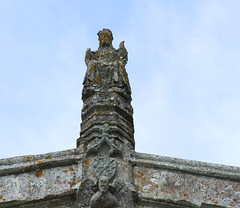 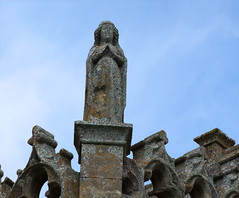 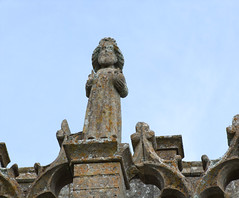
 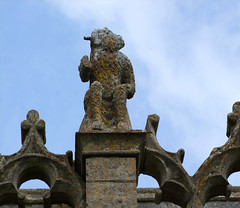 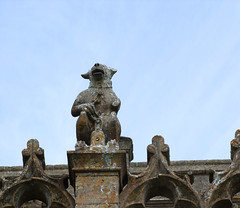 
The porch is part of the late 15th century rebuilding,
but it was considerably restored in the early 20th
century. Interestingly, the angels crowning the
battlements look medieval - but they weren't there in
1900, so must have come from somewhere else. Pretty much
all the porch's features of interest date from this time.
These include the small medieval font pressed into
service as a holy water stoup, and image niche above the
doors. This has been filled in more recent years by an
image if the Holy Trinity; God the Father holds the Son
suspended while a dove representing the Holy Spirit
alights; you can see medieval versions of this at
Framlingham and Little Glemham. Of all medieval imagery,
this was the most frowned upon by puritans. An image of
God the Father was thought the most suspicious of all
idolatries. Indeed, as late as the 1870s, when the
Reverend White edited the first popular edition of the
Diary of William Dowsing, he actually congratulated
Dowsing on destroying images of the Holy Trinity in the
course of his 1644 progress through the counties of
Suffolk and Cambridgeshire.
William Dowsing visited on the morning on April 9th,
1644. It was a Tuesday, and he had spent most of the week
in the area. The previous day he'd been at Southwold and
Walberswick to the east, but preceded his visit here with
one to Blyford, which lies to the west, so he was
probably staying overnight at the family home in
Laxfield. He found twenty images in stained glass to take
to task (a surprisingly small number, given the size of
the place) and two hundred more that were inaccessible
that morning (probably in the great east window). Three
brass inscriptions incurred his wrath (but again, this is
curious; there were many more) and he also ordered down
the cross on the porch and the cross on the tower. Most
significantly of all, he decided the angels in the roof
should go.
Lots of Suffolk churches have angels in their roofs. None
are like Blythburgh's. You step inside, and there they
are, exactly as you've seen them in books and in
photographs. They are awesome, breathtaking. There are
twelve of them. Perhaps there were once twenty. How would
you get them down if ordered to do so? The roof is so
high, and the stencilling of IHS symbols would also have
to go.
Perhaps this was already indistinct by the time Dowsing
visited. Perhaps Tuesday, 9th of April 1644 was a dull
day.
Several of the angels are peppered with lead shot. Here
is another of those Suffolk legends; that Dowsing and the
churchwardens fired muskets at the angels to try and
bring them down. But when the angels were restored in the
1970s, the lead shot removed was found to be 18th
century; contemporary with them there is a note in the
churchwardens accounts that men were paid for shooting
jackdaws living inside the building, so that probably
explains where the shot came from. Here are some details
of that wonderful roof:
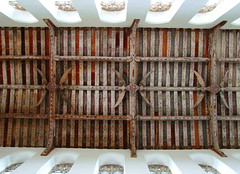 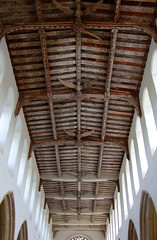 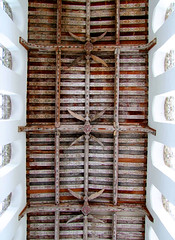 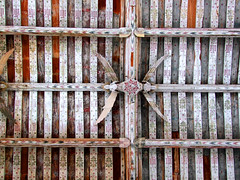
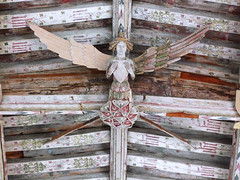 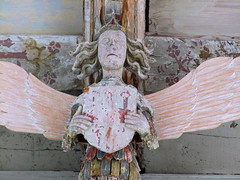 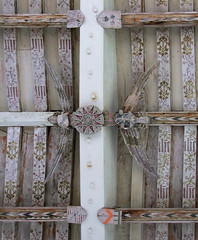 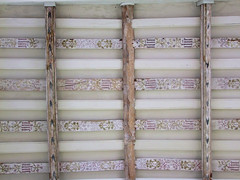 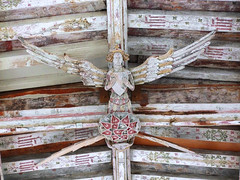
The otherwise splendid church guide
also repeats the error that the Holy Trinity symbol in
the porch filled a gap that had been 'empty since 1644'.
But there was certainly no image in it when Dowsing
arrived here, or anywhere else in Suffolk; statues were
completely outlawed by injunctions in the early years of
the reign of Edward VI, almost a hundred years before the
morning of Dowsing's visit.
Another feature used as evidence of puritan destruction
is the ring fixed into the most westerly pillar of the
north arcade. Cromwell's men stabled their horses here,
apparently. Well, it almost certainly is a ring for tying
horses to, and the broken bricks at the cleared west end
also suggest this; but there is no reason to think that
Cromwell and the puritans were responsible. For a full
century before Cromwell, and for nearly two hundred years
afterwards, a church as big as this would have had a
multitude of uses. Holy Trinity was built for the rituals
of the Catholic church; once these were no longer
allowed, a village like Blythburgh, which can never have
had more than 500 people, would have seen it as an asset
in other ways. It was only with the 19th century
sacramental revival brought about by the Oxford Movement
that we started getting all holy again about our parish
churches. Perhaps it was used as an overnight stables for
passing travellers on the main road; not an un-Christian
use for it to be put to, I think.
In August 1577, a great storm brought down the steeple,
which fell into the church and damaged the font. This was
at the height of Elizabethan superstition, and the devil
was blamed; his hoof marks can still be seen on the
church door. Supposedly, a black dog ran through the
church, killing two parishioners; he was seen the same
day at St Mary, Bungay. Black Shuck is the East Anglian
devil dog, the feared hound of the marshes; and Holy
Trinity is the self-styled Cathedral of the Marshes, so
it is appropriate that he appeared here. You can see
where the font has been broken. You can also see that
this was one of the rare, beautiful seven sacrament
fonts, similar in style to the one at Westhall; but, like
those at neighbouring Wenhaston and Southwold, it has
been completely stripped of imagery. Almost certainly,
this was in the 1540s, but there is a story that the font
at Wenhaston was chiselled clean as part of the 19th
century restoration. More importantly in any case, the
storm, or the dog, or the devil, damaged the roof; it
would not be properly repaired for more than 400 years.
Throughout the 17th and 18th centuries, accounts note
that Holy Trinity is not impregnable to the weather. By
the 19th century, parishioners attended divine service
with umbrellas. By the 1880s, it was a positively
dangerous building to be in, and the Bishop of Norwich
ordered it closed.
Why had Holy Trinity not been restored? Simply, this is a
big church, with a tiny village. There was no rich
patron, and in any case the parishioners had a passion
for Methodism. Probably, repairs had been mooted, but not
a wholesale restoration as we have seen at Lavenham, Long
Melford and Southwold. By the 1880s, attention in England
had turned to the preservation of medieval detail; in
short, restorations were not as ignorant as they had been
a quarter of a century earlier. Suggestions that Holy
Trinity should be restored in the manner of the other
three were blocked by the Society for the Preservation of
Ancient Buildings, and this owed a lot to the energy of
William Morris, the Society's secretary.
The slow, patient restoration of this building took the
best part of a century; indeed, when I first visited in
the 1980s I was still aware of a sense of decay.
Nothing could be further from the truth today. You step
into a wide, white, open space, one of England's great
church interiors. There, high above you, is the glorious
roof and the angels of God. The brick floors spread
around the scraped font, which still bears its dedicatory
inscription and standing places for participants. You
turn into the central gangway, and more than twenty empty
indents for brasses stretch before you. Dowsing can be
blamed for the destruction of hardly any of them. In
reality, you see the work of 18th and 19th century
thieves and collectors.
The bench-ends are superb. The benches themselves were
reconstructed in the late 19th century, supposedly from
the main post of Westleton windmill, but the ends are
some of the county's finest medieval images. There are
partial sets of basically three series: the Seven Deadly
Sins, the Seven Works of Mercy, and the Labours of the
Seasons. There are also angels bearing symbols of the
Holy Trinity and the Crown. There are other figures too,
obscure and fragmentary and whose purpose is unclear, as
if surviving figments of a broken dream. The quality of
what remains makes you grieve for what has been lost.
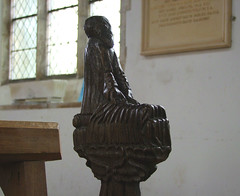 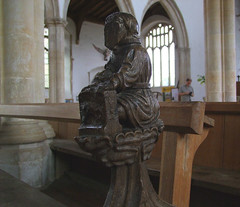 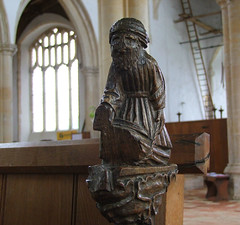 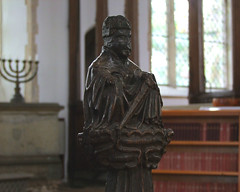 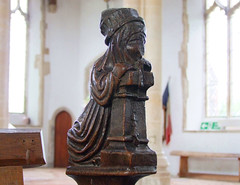 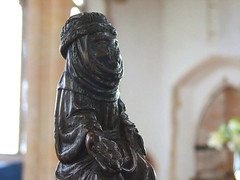 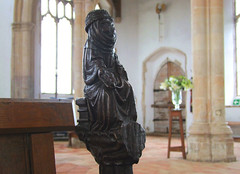 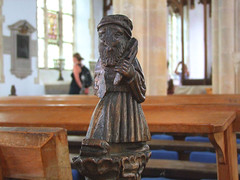  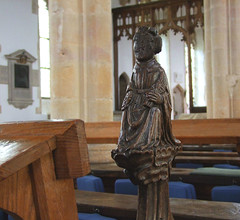 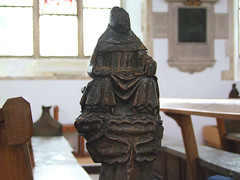 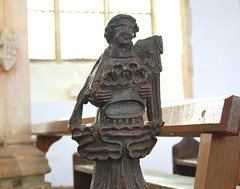 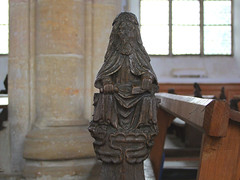 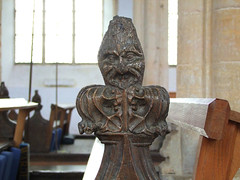 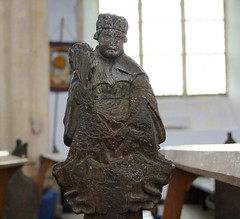 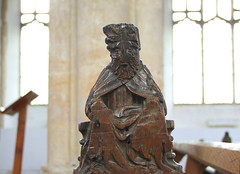
The rood screen is a disappointment; most of it is
modern, and the medieval bits perfunctory and scoured.
Having said this, note how tiny the exit from the north
aisle rood loft stair is. Also at this end of the church,
a scattering of medieval glass, mainly angels. There is
more in the south aisle, including a collection of
shields of the Holy Trinity:
 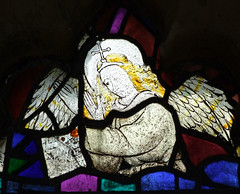 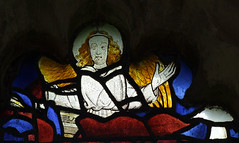 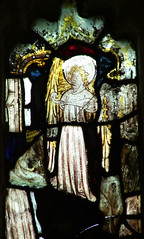 . .
 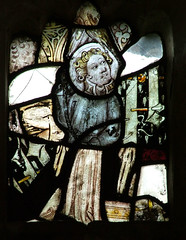 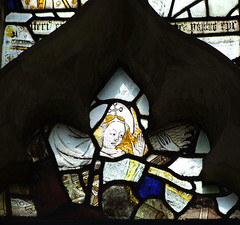 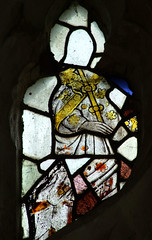 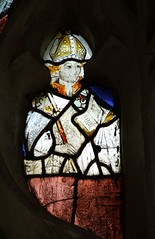 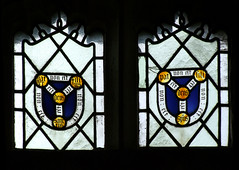
But step through the central aisle to see something
remarkable. The priest and choir stalls are fronted by
exquisite carvings of the Apostles, the Evangelists, John
the Baptist, St Stephen, Mary Queen of Heaven and Christ
in Majesty. Seeing these eighteen carvings is a bit like
gobbling up a very large box of chocolates, but it is
worth stopping to consider quite how genuine they all
are. For a start, there could not have been choir stalls
here in medieval times, and in any case we know that
these desks and their frontages were in the north aisle
chapel until the 19th century. They were used as school
benches in the 17th century; they still bear holes for
inkpots, and the graffiti of a bored Dutch child (his
father was probably working on draining the marshes) is
dated 1665. There is nothing at all like them anywhere
else in Suffolk.
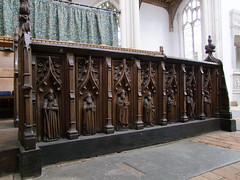 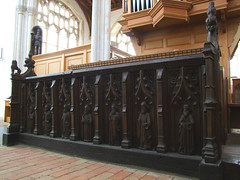
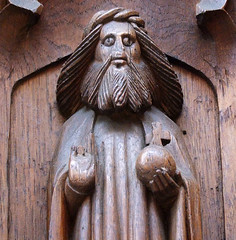 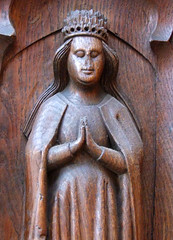 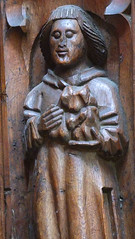 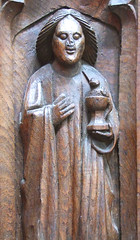 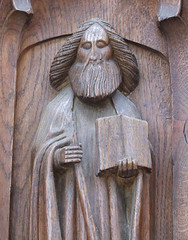 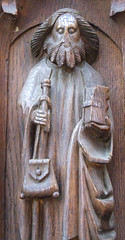 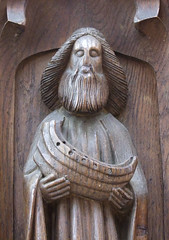 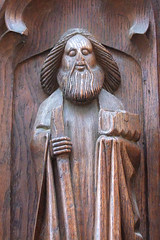 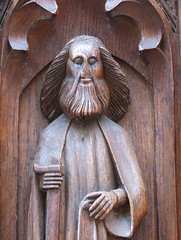 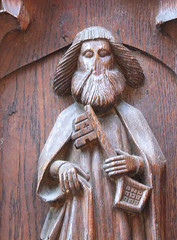 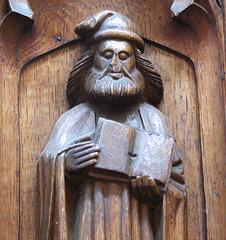 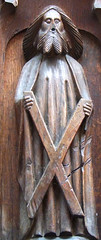 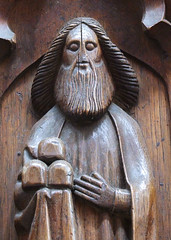 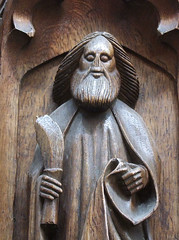 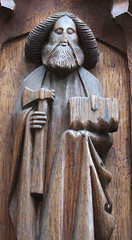 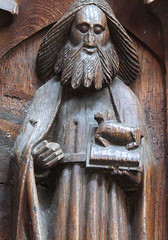 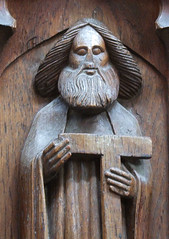
Whatever, the east end of the
chancel and aisles are thrillingly modern, wholly
devotional. In the north aisle, traditionally the Hopton
chantry, extraordinary friezes of skeletons become
symbols of the four evangelists behind the altar. Beside
them is Peter Ball's beautiful Madonna and Child.
Separating the south aisle chapel from the sanctuary is
is one of Suffolk's biggest Easter sepulchres, tomb of
the Hoptons. Behind the high altar, branches arranged
like huge stag antlers spread dramatically. It is all
just about perfect. Tucked to one side of the organ is a
clockjack; Suffolk has two, and the other is down-river
at Southwold. They date from the late 17th century, and
presumably once struck the hours; at high church
Blythburgh and Southwold today, they are used to announce
the entry of the ministers.
This is a wonderful church
to wander around in, the light and the air
changing with the seasons, a suffused sense of
the numinous presenting its different faces
according to the time of day and time of year.
Come here on a bright spring morning, or in the
drowsy heat of a summer's day. Come on a cold
winter afternoon as the colours fade and the
smell of woodsmoke from neighbouring cottages
weaves a spell above the old stone floors and
woodwork. And before you leave, find the doorway
in the south-west corner of the nave. It opens
onto a low, narrow stairway. You can go up it. It
leads up into the parvise storey of the south
porch, now reappointed and dedicated as a tiny
chapel, a peaceful spot to spend a few moments
before continuing your journey.
You may be reading this entry in a far-off land;
or perhaps you are here at home. Whatever, if you
have not visited this church, then I urge you to
do so. It is the most beautiful church in
Suffolk, a wonderful art object, and it is always
open in daylight. It remains one of the most
significant medieval buildings in England. If you
only visit one of Suffolk's churches, then make
it this one. |
|
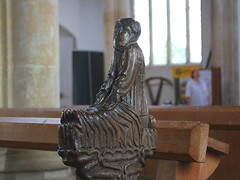 |
|
|
|


